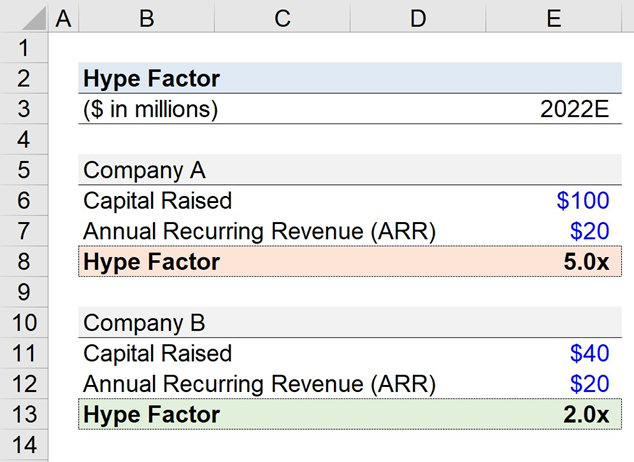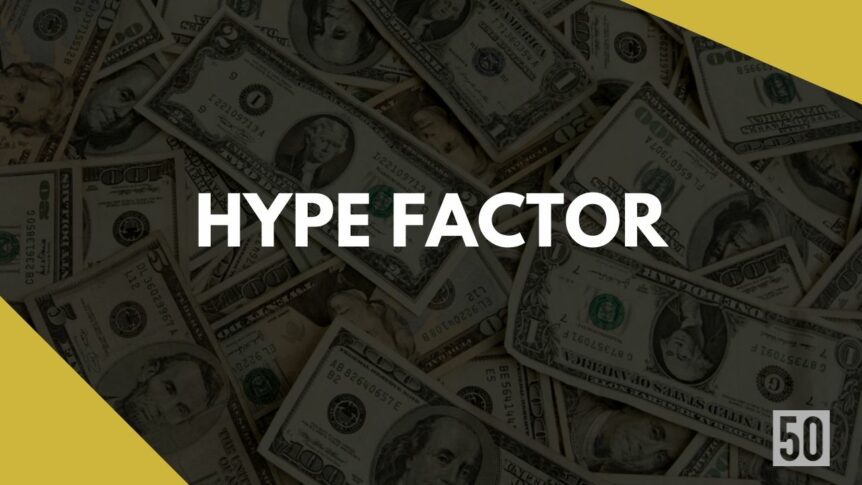Are you looking for a way to make your business stand out from the competition? Are you tired of spending countless hours trying to generate excitement and interest in your upcoming projects or products but feeling like something is still missing? Then it’s time to up the ante, increase visibility, and start leveraging the power of hype! Hype Factor- A complete guide will provide you with all the tips and strategies necessary for creating an exciting buzz about whatever it is you’re striving to promote. Stop struggling with lackluster results – get the inside scoop on how introducing an element of anticipation through effective prelaunch marketing can maximize engagement with potential customers and skyrocket sales.
What is the Hype Factor?
The Hype Factor metric is a measure of efficiency that reveals how well a firm utilizes the capital it has raised to generate annual recurring revenue (ARR). As with any SaaS business, venture capital can be put towards two things: ARR and promotion.
ARR incurs direct value over time as it eventually turns into GAAP revenue. Meanwhile, the promotion of a company can be beneficial in terms of creating a positive reputation and boosting interest, which all have the potential to increase ARR. The Hype Factor metric is an effective way to measure how well these two strategies are working in tandem.
Why Is It Important For Startups to track the Hype Factor?
Following are the reasons why tracking the Hype Factor is important for Startups:
1. Helps in Brand Building:
Tracking the Hype Factor can help startups build their brand, especially if they are just starting off. It gives them an understanding of how their product is being perceived by potential customers and what the overall sentiment towards their product is. This data helps them understand how much hype they have generated around their product and what needs to be done in order to further create buzz and hype.
2. Monitoring Competition:
Tracking the Hype Factor can also help startups monitor their competitors’ activities. By understanding how much hype a rival product/service has created, it gives them an insight into the current market trend and what strategies they should adopt to stay competitive
3. Improving Product Design:
Tracking the Hype Factor can also help startups improve their product design. By understanding how much hype a similar product has created, they can create a better version of it and launch it in the market before their rivals have time to catch up.
4. Optimizing Strategies:
Finally, tracking the Hype Factor also helps startups optimize their marketing strategies. They can understand which channels are creating the most hype and allocate resources accordingly to maximize returns on investment.
Overall, tracking the Hype Factor is important for startups in order to understand the current market sentiment, monitor competitors’ activities, improve product design, and optimize their marketing strategies.
How To Calculate the Hype Factor?
Here is the formula to calculate the Hype Factor:

Let’s suppose a startup has raised $20 million in capital and has an annual recurring revenue of $2 million.
The Hype Factor for this company would be 10 ($20 million ÷ $2 million). This means that the company is currently overvalued by 10x its current revenue potential.
What factors affect the Hype Factor?
The following factors affect the Hype Factor:
1. Brand recognition:
Companies with more brand recognition often have higher hype factors as they are more likely to receive positive press and public attention.
2. Virality:
If a company’s content or message is able to spread quickly through social media platforms, word of mouth, or other forms of communication then its metrics will likely be higher than
those of companies with lower virality.
3. Novelty:
Companies that offer something new or different often have a higher hype factor as they generate more interest from the public and media outlets.
4. Quality:
Companies that are perceived to provide high-quality products and services tend to have higher hype factor metrics than those that don’t
5. Timing:
Companies that are able to capitalize on current trends or seasonal events tend to have higher hype factor metrics than those that don’t.
6. Promotion:
Companies that invest in marketing and advertising campaigns often have higher hype factor metrics as their message reaches more people and generates more interest.
7. Reach:
Companies with greater reach (e.g., those with larger audiences) tend to have higher hype factor metrics than those with lower reach.
8. Connections:
Companies that are able to leverage relationships and partnerships often have higher hype factor metrics as they benefit from increased visibility and exposure.
9. Social Media:
Companies that make use of social media platforms (e.
g., Facebook, Twitter, Instagram) often have higher hype factor metrics as they are able to reach a larger audience.
10. Content:
Companies that create content or messages that resonate with their target audience often have higher hype factor metrics than those that don’t.
What is a Good Hype Factor?
According to Kellogg, the hype factor should be evaluated using the following criteria. A rating of 1 to 2 indicates that it is at a target level. A score of 2 to 3 suggests that it is good, particularly for a company in the IPO stage. Ratings between 3 and 5 indicate that there may not be enough annual recurring revenue (ARR) to justify the hype.
A rating of 5 or higher signals that there is very little ARR in the equation and it is all just hype. Typically, software companies on the cusp of an IPO have a hype factor of around 1.5.
What is an example of a Hype Factor?
We can assess the hype factor of two separate startups – Company A and Company B – by dividing their capital raised by their projected Annual Recurring Revenue (ARR) in 2022. Company A raised $100 million while Company B only raised $40 million, yet both are estimated to generate the same amount of ARR, which is $20 million.
When calculating the hype factor, we can see that Company A has a much higher ratio of 5.0x (100 million/20 million), whereas Company B has a lower ratio of 2.0x (40 million/20 million). This indicates that Company B is more efficient at converting investor capital into ARR and thus is in better shape than Company A.

Tips to improve the Hype Factor
following strategies can help to improve the Hype Factor:
1. Utilize Social Media Platforms:
Creating and managing an engaging social media presence is essential to developing your brand’s hype factor. Leverage popular platforms like Facebook, Twitter, Instagram, Snapchat, and YouTube to showcase the unique value that you offer customers and increase engagement with potential leads.
2. Invest in Quality Content Marketing:
Consumers have increasingly higher expectations for content quality, so investing in high-quality, creative content is essential for developing and maintaining a company’s hype factor. Content should be tailored to the interests and needs of your target audience and provide value that sets you apart from your competitors.
3. Develop an Authentic Brand Voice:
A brand’s voice is the most effective way to create a memorable presence with customers. Developing an authentic, unique voice that resonates with your desired audience is essential for long-term success and boosting the hype factor.
4. Foster Collaborations:
Seeking out strategic collaborations is a great way to boost brand exposure, credibility, and the overall hype factor of your business. Collaborations can range from influencer marketing campaigns to partnerships with industry leaders and even charitable causes that align with the mission of your company.
5. Offer Premium Experiences:
Offering customers exclusive experiences is a great way to generate excitement and increase the hype factor of your brand. This could include VIP shopping events, product previews, and exclusive discounts or deals. These experiences make customers feel special and show them that your brand values their loyalty and business.
6. Leverage Visual Media:
With the increased popularity of visual platforms like Instagram, YouTube, and TikTok, businesses should be leveraging these channels to create a buzz around their products or services. Utilizing visually-appealing imagery and videos to showcase the unique value of your brand is essential for creating a memorable presence.
7. Invest in Paid Advertising:
Paid advertising campaigns are a great way to get your name out there and increase visibility with potential customers. Investing in paid campaigns on popular sites like Google, Facebook, or YouTube can help you reach a larger audience and boost the hype factor of your brand.
8. Host Exciting Events:
Hosting exciting events like product launches, industry conferences, or charity fundraisers are great ways to generate buzz and increase the hype factor for your business. Events can be used to showcase the unique value of your brand, engage with existing customers and inspire new customers to take an interest.
9. Create a Loyalty Program:
Loyalty programs are great for increasing customer engagement and generating buzz around your brand. Offering exclusive rewards and discounts to loyal customers can not only increase sales but boost the hype factor of your business as customers start to spread the word about their positive experiences with your brand.
10. Stay on Top of Industry Trends:
To maintain a high hype factor and keep customers interested in your brand, it is important to stay on top of industry trends and utilize them to create innovative products or services that give customers something unique and interesting. Keeping up with the latest trends can help you stay ahead of the competition and inspire customer loyalty.
These strategies can help you improve the hype factor of your business and achieve greater success. With the right focus and effort, your business can become more popular with customers, generate greater revenue, and gain a competitive edge.
The Bottom Line
While the “hype factor” can be beneficial in some cases, it’s important to not get too caught up in the hype. When evaluating a product, service, or company, be sure to do your own research and make an informed decision. Be careful of letting the “hype” influence your decision-making process.

